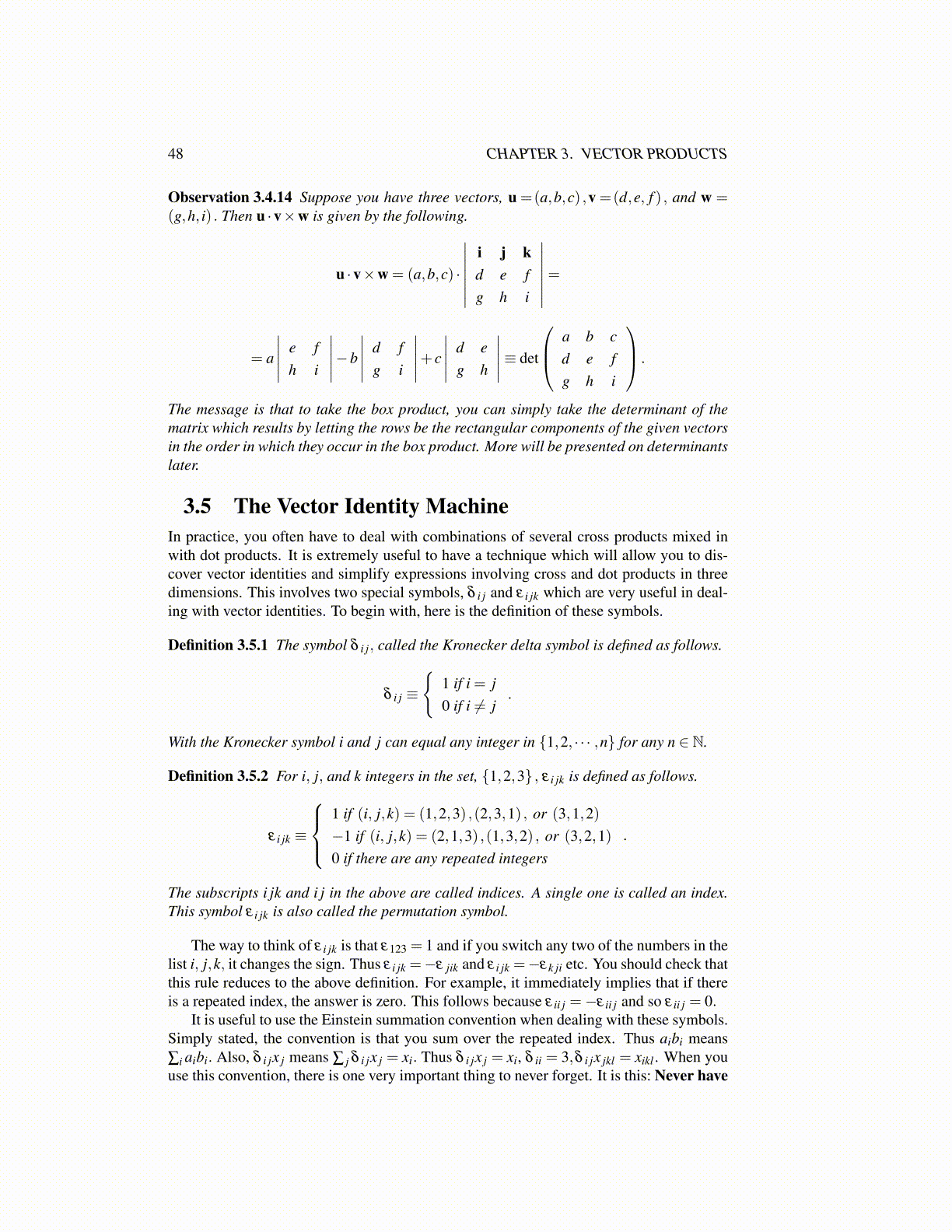
48 CHAPTER 3. VECTOR PRODUCTS
Observation 3.4.14 Suppose you have three vectors, u =(a,b,c) ,v =(d,e, f ) , and w =(g,h, i) . Then u ·v×w is given by the following.
u ·v×w = (a,b,c) ·
∣∣∣∣∣∣∣i j kd e fg h i
∣∣∣∣∣∣∣=
= a
∣∣∣∣∣ e fh i
∣∣∣∣∣−b
∣∣∣∣∣ d fg i
∣∣∣∣∣+ c
∣∣∣∣∣ d eg h
∣∣∣∣∣≡ det
a b cd e fg h i
.
The message is that to take the box product, you can simply take the determinant of thematrix which results by letting the rows be the rectangular components of the given vectorsin the order in which they occur in the box product. More will be presented on determinantslater.
3.5 The Vector Identity MachineIn practice, you often have to deal with combinations of several cross products mixed inwith dot products. It is extremely useful to have a technique which will allow you to dis-cover vector identities and simplify expressions involving cross and dot products in threedimensions. This involves two special symbols, δ i j and ε i jk which are very useful in deal-ing with vector identities. To begin with, here is the definition of these symbols.
Definition 3.5.1 The symbol δ i j, called the Kronecker delta symbol is defined as follows.
δ i j ≡
{1 if i = j0 if i ̸= j
.
With the Kronecker symbol i and j can equal any integer in {1,2, · · · ,n} for any n ∈ N.
Definition 3.5.2 For i, j, and k integers in the set, {1,2,3} , ε i jk is defined as follows.
ε i jk ≡
1 if (i, j,k) = (1,2,3) ,(2,3,1) , or (3,1,2)−1 if (i, j,k) = (2,1,3) ,(1,3,2) , or (3,2,1)0 if there are any repeated integers
.
The subscripts i jk and i j in the above are called indices. A single one is called an index.This symbol ε i jk is also called the permutation symbol.
The way to think of ε i jk is that ε123 = 1 and if you switch any two of the numbers in thelist i, j,k, it changes the sign. Thus ε i jk =−ε jik and ε i jk =−εk ji etc. You should check thatthis rule reduces to the above definition. For example, it immediately implies that if thereis a repeated index, the answer is zero. This follows because ε ii j =−ε ii j and so ε ii j = 0.
It is useful to use the Einstein summation convention when dealing with these symbols.Simply stated, the convention is that you sum over the repeated index. Thus aibi means∑i aibi. Also, δ i jx j means ∑ j δ i jx j = xi. Thus δ i jx j = xi, δ ii = 3,δ i jx jkl = xikl . When youuse this convention, there is one very important thing to never forget. It is this: Never have